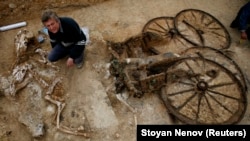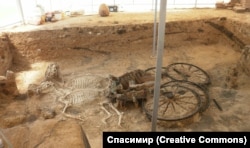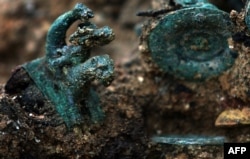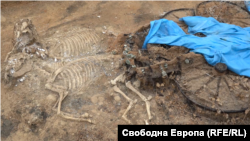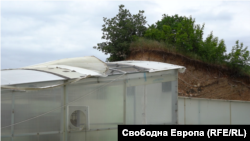The nighttime theft of archaeological treasures near the famous Thracian chariot of Karanovo highlights the threats to Bulgaria’s ancient heritage.
In 2008, this hillock made international headlines when a Thracian chariot -- along with the skeletons of two horses and a hunting dog -- were uncovered by Bulgarian archaeologists.
But wrangling over responsibility for the site’s protection has now apparently resulted in the loss of another priceless treasure nearby.
The chariot was hailed as one of the most important discoveries made in Bulgaria thanks to the completeness of the Thracian vehicle, which included traces of wood and leather that had survived 2,000 years underground.
Thracians were an ancient race who lived “wildly on the high mountains” of the Balkans for roughly 1,000 years. Their warring, disparate tribes were known for their magnificent art. Perhaps the most famous Thracian was the rebel slave Spartacus.
Like most burials of Thracian nobles, the Karanovo site was scattered with exquisite treasures such as this silver and gold cup of a dancing Eros. Similar vessels have sold at auctions for tens of thousands of dollars.
In March, police were called after treasure hunters dug up and stole at least one more unknown chariot near Karanovo.
Veselin Ignatov, who was the head archaeologist for the team that excavated the Karanovo mound in 2008, told RFE/RL’s Bulgarian Service that when he arrived in late March “I found that treasure hunters had made excavations 50 meters east of the mound…. I found several fragments of chariots. That's how I discovered that parts of the chariots were unfortunately destroyed by the treasure hunters."
The brazen theft was possible because security measures set up at the Karanovo mound had lapsed by early 2021. There was no security staff on site and cameras had reportedly stopped working.
The failure stems from a long-running dispute between Bulgaria’s Culture Ministry and the city government that oversees the region around Karanovo. Since the local government took over management of the site, the temporary shelter for the chariot has slowly fallen into disrepair and security for the site petered out completely by early 2021.
Since the March theft, the Karanovo mound has come back under the control of Bulgaria’s Culture Ministry and security measures were reinstated. A ministry spokeswoman told RFE/RL that plans are also under way to replace the cover that is currently allowing rain to dribble onto the Karanovo chariot.
The theft near Karanovo is only the latest of hundreds in Bulgaria, where a black market in looted Thracian treasures is said to thrive.
Ignatov told RFE/RL his research suggests that some 150 chariots and their associated treasures have been stolen by criminals armed with metal detectors throughout Bulgaria in recent years.
"And so," Ignatov says, "information disappeared that could have opened and filled new pages in the history of ancient personal transport."
Written by Amos Chapple based on reporting by Elitza Simeonova of RFE/RL's Bulgarian Service.




